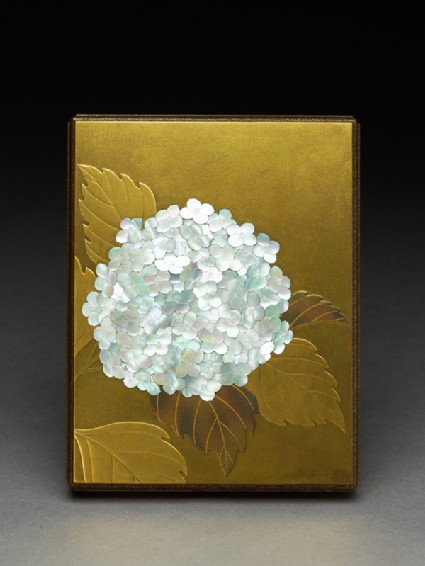Search Results: objects
Show search help- Reference URL
Actions
Box with a hydrangea flower
-
Details
- Associated place
- Date
- c. 1900
- Material and technique
- wood, inlaid with pearl shell, and with takamaki-e, togidashi maki-e, and nashiji lacquer decoration
- Dimensions
- 5.8 x 15.3 x 12 cm (height x width x depth)
- Material index
-
organic › animal › shell › pearlshell,
- Technique index
- Object type index
- No. of items
- 2
- Credit line
- Presented by Sir Herbert Ingram, 1956.
- Accession no.
- EA1956.3337
-
Further reading
Impey, Oliver, and Joyce Seaman, Japanese Decorative Arts of the Meiji Period 1868-1912, Ashmolean Handbooks (Oxford: Ashmolean Museum, 2005), no. 49 on p. 102, illus. p. 103
Impey, O. R., and M. Tregear, Oriental Lacquer: Chinese and Japanese Lacquer from the Ashmolean Museum Collections (Oxford: Ashmolean Museum, 1983), no. 14 b on p. xi, illus. p. 14
Glossary (6)
lacquer, maki-e, nashiji, takamaki-e, togidashi, togidashi maki-e
-
lacquer
Chinese and Japanese lacquer is made from the sap of the lacquer tree, which is indigenous to Eastern China. It is applied to wood as a varnish or for decorative effect. In India and the Middle East, lacquer is made from the deposit of the lac insect.
-
maki-e
(‘sprinkled design’) generic term for lacquer decoration using powdered metals sprinkled onto wet lacquer to create a design
-
nashiji
(‘pear skin ground’) tiny, irregularly shaped flakes of gold embedded in amber coloured wet lacquer and then polished to a fine sheen
-
takamaki-e
(high relief sprinkled design’) makie technique in which parts of the design are built up with lacquer mixed with charcoal or clay dust
-
togidashi
Technique in which the design in metal powders sprinkled over damp lacquer, is permitted to harden, then entirely covered with lacquer and finally after hardening, polished with abrasives to re-expose the design.
-
togidashi maki-e
(‘sprinkled designs revealed by polishing’) a type of makie in which the sprinkled design is covered with lacquer that is then polished away so that the design reappears flush with the surface
Location
Objects are sometimes moved to a different location. Our object location data is usually updated on a monthly basis. Contact the Jameel Study Centre if you are planning to visit the museum to see a particular object on display, or would like to arrange an appointment to see an object in our reserve collections.
Galleries
Publications online
-

Oriental Lacquer: Chinese and Japanese Lacquer from the Ashmolean Collections
Box with inlay and raised lacquer. A hydrangea inlaid in pearl shell, with the leaves in raised and polished lacquer. Nashiji corners and interior. -

Japanese Decorative Arts of the Meiji Period
Rectangular box with a design on the lid and sides of hydrangea leaves in raised lacquer (takamaki-e), the flower in high relief pearl shell. The canted corners of nashiji and the interior and base of densely sprinkled gold flakes (nashiji).
Crusted inlay of pearl-shell or other materials is an old Japanese technique, originally derived from Chinese models that were imported as early as the 6th century. But as with almost all 'borrowed' techniques, the Japanese developed their own way of doing things, by selection and rejection, until the results may far surpass the original models. The use of several techniques upon one object is almost a commonplace in Japanese work of the finest quality.
Bought by the Ingrams in Yokohama in June 1908 for 55 yen; quite a high price.
© 2013 University of Oxford - Ashmolean Museum










